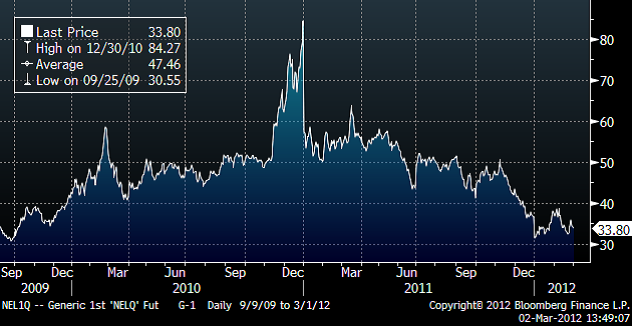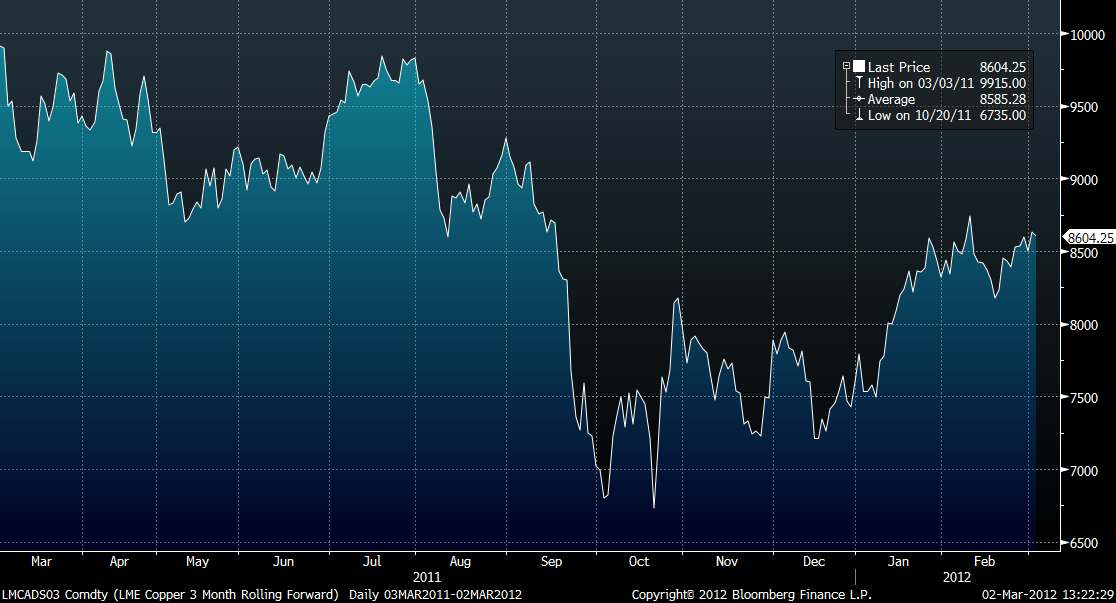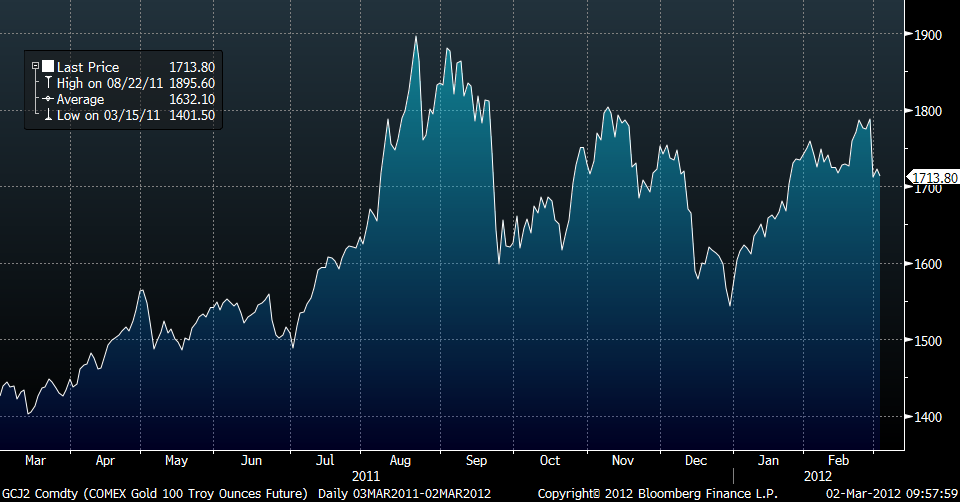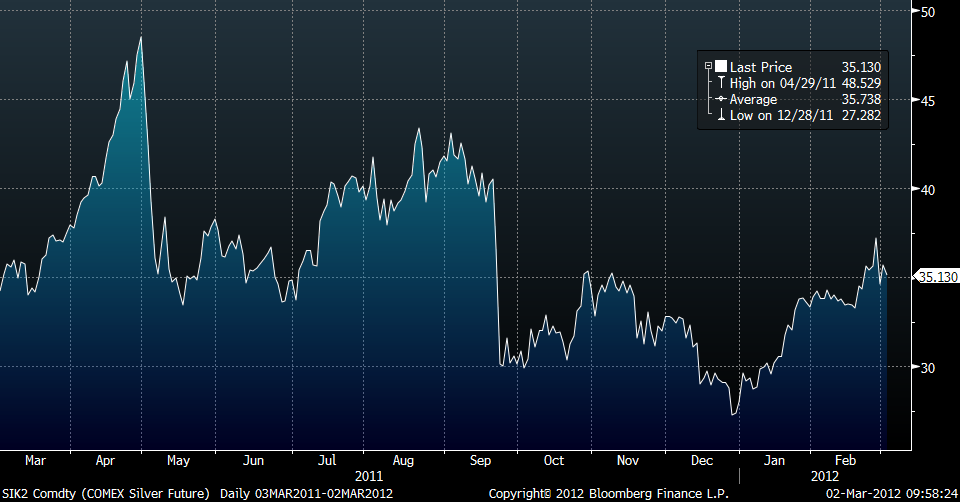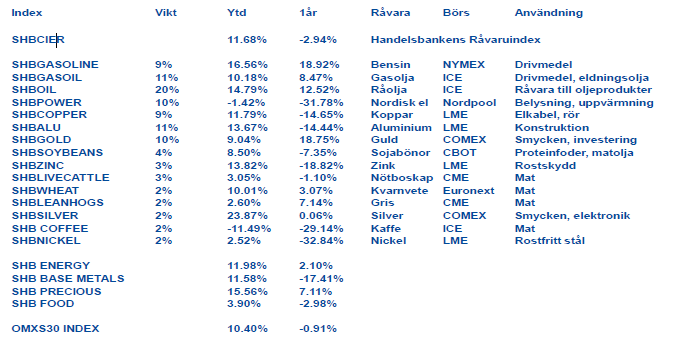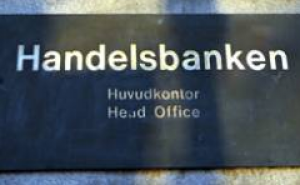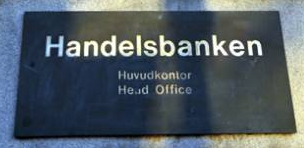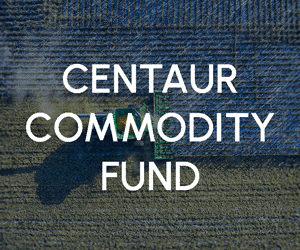Analys
SHB Råvarubrevet 2 mars 2012
 Våra vyer:
Våra vyer:
- Energi: Positiv
- Basmetaller: Positiv
- Ädelmetaller: Negativ
- Livsmedel: Neutral till Positiv (negativ på vete)
I onsdags kom den Europeiska centralbanken med LTRO2, en repa som ger cirka 300mdr nytryckta EUR som nu skvalpar omkring och överlikvidiserar eurosystemet i än högre grad än tidigare. Svallvågorna kommer att märkas i alla likviditetsdrivan tillgångar. Vi har rekommenderat vår basmetallkorg som en bra position för denna aktion. USA:s ekonomi ser ut att stå på en stabilare grund i ljuset av de senaste revideringarna av data under veckan, det sämre inköpschefsindexet till trots. Den Europeiska kalendern innehåller som vanligt flera potentiella oroshärdar men arbetsmarknadsdata talar för ytterligare räntesänkningar från ECB.
Vi förväntar oss alltså fortsatt tryck uppåt på råvaror av alla de slag: banker som valt att delta i den senaste LTRO:n använder inte den nya likviditeten direkt. Snarare bör man tala om en gradvis process som ger stöd under de kommande veckorna.
I USA har förväntningarna på ytterligare stimulanser dämpats efter Bernankes tal i onsdagskväll att Fed skulle sjösätta QE3 i en miljö med förbättrade konjunkturutsikter och stigande inflationsförväntningar framstod för oss som osannolikt. Guld och silver hade dock prisat in mer QE och föll båda skarpt på beskedet.
Det oväntade fallet i amerikanska inköpschefsindex ISM för tillverkningsindustrin skapar viss oro för tillväxtutsikterna. Vi tror dock att det är för tidigt att dra några större växlar av detta, bland annat då ISM har överskattat tillväxten rejält de senaste åren, hursomhelst så stiger spänningen kring konjunkturen i USA. Empiriskt sett tenderar även bensinpriset att påverka finansiella marknader negativt med en fördröjning på 13-22 veckor. Även detta är något att hålla ett öga på under våren. Ryktesvågen skapad av att iransk tv rapporterat att en pipeline i Saudi skulle ha sprängts har fått oljan att skena och späder på konjunktur-oron kring höga oljepris.
Energi (positiv)
Olja
Oljepriset (Brent) steg kraftigt under torsdagen och passerade 128 USD/fat efter iranska medier rapporterade om en oljeledning som exploderade i Saudi Arabien. Detta förnekades senare av Saudi Arabiska representanter vilket fick oljepriset att falla tillbaka. Under fredag eftermiddag handlades aprilkontraktet för 124,7 USD/fat vilket var 0,7 % lägre än förra veckan. Flera källor rapportera nu att sanktionerna mot Iran börja få effekt. Enligt Wall Street Journal har asiatiska rederier slutat använda vissa passager till Iran.
USA:s råvarulager steg till 4,2 miljoner fat (väntat 1,1 miljoner fat) medan destillat lagren sjönk med 2,1 miljoner (väntat 0,3 miljoner fat). Bensin lagren sjönk med 1,6 miljoner fat (väntat 0,3 miljoner fat).
Elmarknaden (neutral)
Elmarknaden har försvagats något ytterligare under veckan då vädret är fortsatt milt och vått. Väderprognoserna är dessutom både varmare och blötare än normalt vilket resulterat i att kontraktet Q2 2012 tappat lite drygt 1.5 procent och handlas nu under 34 euro per MWh.
De senaste prognoserna pekar på nederbörd om mellan 3.3 och 7.2 TWh, ca 25 procent över normalt för perioden, men lösningarna på slutet är extrema vilket innebär en stor osäkerhet mot nästa helg. Ser vi till energibalansen skulle det innebära en förbättring om ca 2.5 TWh till ett totalt överskott om ca 9.5 TWh efter vecka 10. Inga stora förändringar vad gäller kärnkraften men ett visst bortfall av produktion, Ringhals 2 har en felande ventil och Oskarshamn 1 har skador på turbinen, både förväntas dock vara tillbaka inom 10-12 dagar. Efterfrågan på energikol är låg till följd av det varma vädret. API2 kontraktet handlas fortsatt över 100 dollar men det höga oljepriset har inte fått någon effekt på kolet utan det ser snarare ut som om den svaga spotmarknaden på kol kan komma att pressa de något längre kolkontrakten ytterligare. Detta kommer att påverka elpriset negativt. Flertalet faktorer pekar nedåt men elmarknaden håller upp förhållandevis väl vilket gör att vi förväntar oss sidledes rörelser på el de kommande dagarna. Om prognoserna slår om under helgen och tappar delar av nederbörden mot slutet bör vi kunna se 1-2 euro rörelse upp på Q2 2012, om kolmarknaden däremot viker ner under 100 dollar kan vi komma att tappa 1-2 euro på Q2 2012.
Basmetaller (positiv)
Basmetallerna stänger veckan med blandat resultat, upp för samtliga metaller förutom nickel och bly som föll med 2,5 % respektive 1,5 %. Året har börjat starkt för metallerna samtidigt som lagernivåerna fortsatt att stiga på både i Kina och LME. I och med ECB:s LTRO2 finns det dock anledning att tro på stigande priser på basmetaller.
Kopparpriset har rört sig i intervallet 8 530 till 8 630 USD under veckan. Uppgången slutade på totalt knappt 1 % och uppgången sedan årets början har varit 10.5 %. Den ekonomiska återhämtningen i Asien (framförallt Kina och Indien) och USA fortsätter, vilket understödjer priset på den röda metallen. Lagren hos LME är fortsatt låga (289 000 ton, vilket också är den lägsta nivån sedan augusti 2009). Order för att ta ut mer metall är samtidigt på 8-årshögsta.
Vi är fortsatt positiva till kopparpriset. Förutom den positiva ekonomiska utvecklingen ser vi också tilltagande problem med att få fram högvärdig koppar ur gruvorna. Vi har läst rapporter från Rio Tinto (ett av världens största gruvbolag) om att deras kopparproduktion föll 23 % förra året, nästan enbart på grund av lägre kopparhalt i malmen.
Ädelmetaller (negativ)
Guld har haft en volatil vecka med relativt kraftiga intradagrörelser. Veckan slutade dock med en nedgång på 3.5%, vilket var den största veckovisa nedgången under 2012. Guldet har gått upp drygt 7 % sedan årsskiftet. Huvudförklaringen till denna veckas nedgång är dollarns styrka, vilket i sin tur beror på att Federal Reserve inte indikerade några ytterligare kvantitativa lättnader. Guldpriset gynnas av låga räntor (vilket kvantitativa lättnader möjliggör), då alternativkostnaden att hålla guld blir lägre. Vår grundsyn till guldpriset är fortfarande negativ. Vi är försiktigt positiva till hur ekonomin kommer utvecklas framöver, vilket kommer sätta stopp för alternativt dämpa den globala räntenedgången. Dessutom har vi vid flera tillfällen pekat på bubbeltendenser i guldpriset. Värt att notera är att guldet har stigit 11 år i rad.
Även silver har haft en volatil vecka, men nedgången blev blygsamma 0.8%. Uppgången under 2012 kan summeras till 19 %, vilket är den största uppgången av alla ädelmetaller. Silverpriset har gått ned mindre relativt guldet och vi anser att anledningen bakom det är att silvret ses som en industriell metall. Silverpriset har även funnit stöd från rapporter om stora nettoinflöden i ETF:er (Exchange Traded Funds). Vi intar en negativ hållning till silver, trots vår tro om en positiv utveckling av världsekonomin. Framförallt tror vi att en starkare dollar kommer påverka silverpriset i negativ riktning.
Livsmedel (neutral till positiv)
Vete (negativ)
Terminspriser på vete noteras högre i både Paris och Chicago sedan förra veckan, delvis som följd av rapporter om utvintringsskador i bland annat Frankrike och Tyskland – vilket nog ännu är för tidigt att göra en säker och korrekt bedömning om. Vädret är gynnsamt nu och i dagsläget finns ingen oro för ytterligare skador, detsamma gäller för Ryssland och Ukraina. Regn och snö har fallit i stora delar av USA vilket gynnat höstvetet, mer regn behövs men än så länge inga större skäl till oro. Vintern hämmar fortfarande den ryska exporten genom logistiska problem, det finns förmodligen gott om vete som ska säljas innan ny skörd ska in vilket kan pressa priserna lite längre fram. Höstvete tål ofta mycket mer än marknaden befarar och samtidigt bör marknaden reagera inte alltför starkt på bortfall då tillgången på vete är mer än god.
Majs
Majsen i Chicago har gått upp något i pris sedan förra veckan, påverkat bland annat av stigande priser på vete och råolja. I Argentina pekar väderprognoserna nu på fler regndagar än torra dagar fram till mitten av nästa vecka, vilket är bra för den sent sådda grödan men hindrar skörden av mogen gröda. Väderproblemet blir dock ett allt mindre problem ju närmare skördens avslut vi kommer och det finns i dagsläget inga skäl till ytterligare nedjusteringar, dock ligger USDA fortfarande något högt i sin prognos jämfört med flera privata analytiker i Sydamerika. Amerikanska majspriser bör kunna gå ned i pris om prognoserna om rekordhög areal faller in, men grödan ska först sås och visst stöd kommer ifrån rykten om ett ökat köpintresse från Kina.
Sojabönor
Sojapriserna i Chicago har stigit i pris sedan förra veckan, påverkat av stigande priser på råolja men även som följd av ökat intresse från Kina som köpt 175.000 ton av gammal skörd och 110.000 ton av kommande skörd från USA. Mer stöd till uppgången har kommit ifrån ytterligare nedjusteringar av den sydamerikanska skörden, flera privata lokala analytiker spår en skörd omkring 14 miljoner ton under förra årets, vilket dessutom är 7 miljoner ton under USDA:s nuvarande prognos. Uppgången har varit ganska långvarig nu och det krävs nog ytterligare nedjusteringar av den sydamerikanska skörden för att gå så mycket högre, samtidigt minskar möjligheterna för det ju närmare skördens avslut vi kommer.
Handelsbankens Råvaruindex
[box]SHB Råvarubrevet är producerat av Handelsbanken och publiceras i samarbete och med tillstånd på Råvarumarknaden.se[/box]
Ansvarsbegränsning
Detta material är producerat av Svenska Handelsbanken AB (publ) i fortsättningen kallad Handelsbanken. De som arbetar med innehållet är inte analytiker och materialet är inte oberoende investeringsanalys. Innehållet är uteslutande avsett för kunder i Sverige. Syftet är att ge en allmän information till Handelsbankens kunder och utgör inte ett personligt investeringsråd eller en personlig rekommendation. Informationen ska inte ensamt utgöra underlag för investeringsbeslut. Kunder bör inhämta råd från sina rådgivare och basera sina investeringsbeslut utifrån egen erfarenhet.
Informationen i materialet kan ändras och också avvika från de åsikter som uttrycks i oberoende investeringsanalyser från Handelsbanken. Informationen grundar sig på allmänt tillgänglig information och är hämtad från källor som bedöms som tillförlitliga, men riktigheten kan inte garanteras och informationen kan vara ofullständig eller nedkortad. Ingen del av förslaget får reproduceras eller distribueras till någon annan person utan att Handelsbanken dessförinnan lämnat sitt skriftliga medgivande. Handelsbanken ansvarar inte för att materialet används på ett sätt som strider mot förbudet mot vidarebefordran eller offentliggörs i strid med bankens regler.
Analys
Tightening fundamentals – bullish inventories from DOE
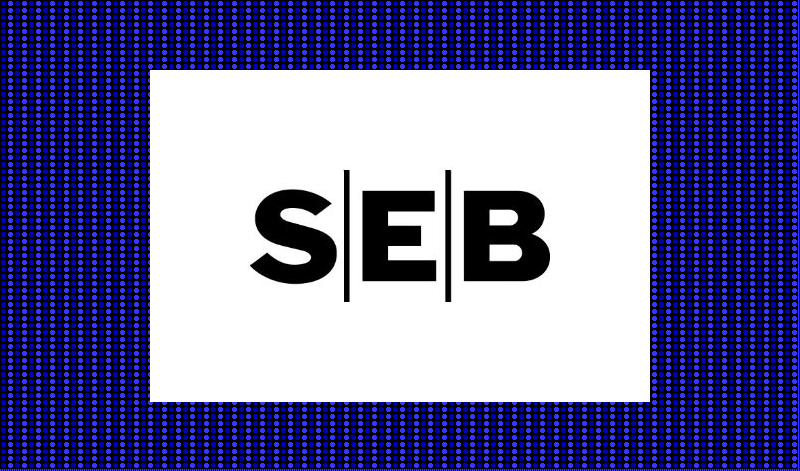
The latest weekly report from the US DOE showed a substantial drawdown across key petroleum categories, adding more upside potential to the fundamental picture.

Commercial crude inventories (excl. SPR) fell by 5.8 million barrels, bringing total inventories down to 415.1 million barrels. Now sitting 11% below the five-year seasonal norm and placed in the lowest 2015-2022 range (see picture below).
Product inventories also tightened further last week. Gasoline inventories declined by 2.1 million barrels, with reductions seen in both finished gasoline and blending components. Current gasoline levels are about 3% below the five-year average for this time of year.
Among products, the most notable move came in diesel, where inventories dropped by almost 4.1 million barrels, deepening the deficit to around 20% below seasonal norms – continuing to underscore the persistent supply tightness in diesel markets.
The only area of inventory growth was in propane/propylene, which posted a significant 5.1-million-barrel build and now stands 9% above the five-year average.
Total commercial petroleum inventories (crude plus refined products) declined by 4.2 million barrels on the week, reinforcing the overall tightening of US crude and products.
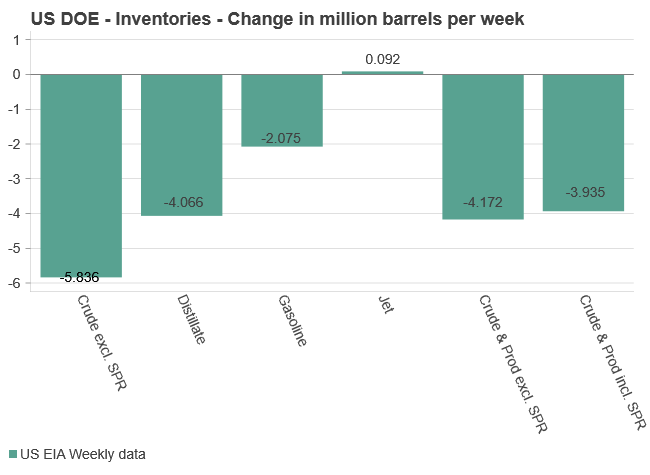
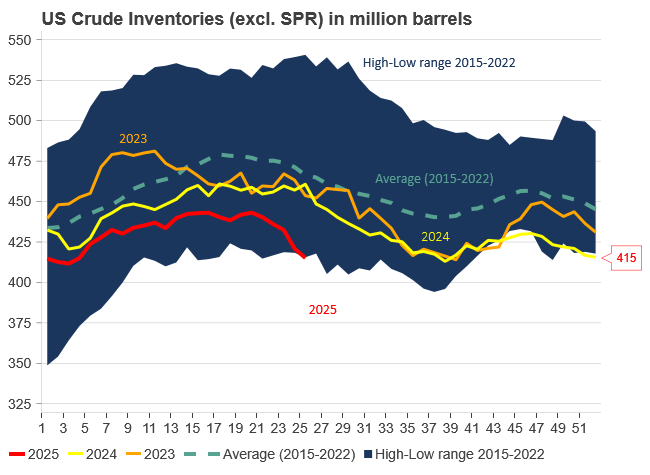
Analys
Bombs to ”ceasefire” in hours – Brent below $70

A classic case of “buy the rumor, sell the news” played out in oil markets, as Brent crude has dropped sharply – down nearly USD 10 per barrel since yesterday evening – following Iran’s retaliatory strike on a U.S. air base in Qatar. The immediate reaction was: “That was it?” The strike followed a carefully calibrated, non-escalatory playbook, avoiding direct threats to energy infrastructure or disruption of shipping through the Strait of Hormuz – thus calming worst-case fears.

After Monday morning’s sharp spike to USD 81.4 per barrel, triggered by the U.S. bombing of Iranian nuclear facilities, oil prices drifted sideways in anticipation of a potential Iranian response. That response came with advance warning and caused limited physical damage. Early this morning, both the U.S. President and Iranian state media announced a ceasefire, effectively placing a lid on the immediate conflict risk – at least for now.
As a result, Brent crude has now fallen by a total of USD 12 from Monday’s peak, currently trading around USD 69 per barrel.
Looking beyond geopolitics, the market will now shift its focus to the upcoming OPEC+ meeting in early July. Saudi Arabia’s decision to increase output earlier this year – despite falling prices – has drawn renewed attention considering recent developments. Some suggest this was a response to U.S. pressure to offset potential Iranian supply losses.
However, consensus is that the move was driven more by internal OPEC+ dynamics. After years of curbing production to support prices, Riyadh had grown frustrated with quota-busting by several members (notably Kazakhstan). With Saudi Arabia cutting up to 2 million barrels per day – roughly 2% of global supply – returns were diminishing, and the risk of losing market share was rising. The production increase is widely seen as an effort to reassert leadership and restore discipline within the group.
That said, the FT recently stated that, the Saudis remain wary of past missteps. In 2018, Riyadh ramped up output at Trump’s request ahead of Iran sanctions, only to see prices collapse when the U.S. granted broad waivers – triggering oversupply. Officials have reportedly made it clear they don’t intend to repeat that mistake.
The recent visit by President Trump to Saudi Arabia, which included agreements on AI, defense, and nuclear cooperation, suggests a broader strategic alignment. This has fueled speculation about a quiet “pump-for-politics” deal behind recent production moves.
Looking ahead, oil prices have now retraced the entire rally sparked by the June 13 Israel–Iran escalation. This retreat provides more political and policy space for both the U.S. and Saudi Arabia. Specifically, it makes it easier for Riyadh to scale back its three recent production hikes of 411,000 barrels each, potentially returning to more moderate increases of 137,000 barrels for August and September.
In short: with no major loss of Iranian supply to the market, OPEC+ – led by Saudi Arabia – no longer needs to compensate for a disruption that hasn’t materialized, especially not to please the U.S. at the cost of its own market strategy. As the Saudis themselves have signaled, they are unlikely to repeat previous mistakes.
Conclusion: With Brent now in the high USD 60s, buying oil looks fundamentally justified. The geopolitical premium has deflated, but tensions between Israel and Iran remain unresolved – and the risk of missteps and renewed escalation still lingers. In fact, even this morning, reports have emerged of renewed missile fire despite the declared “truce.” The path forward may be calmer – but it is far from stable.
Analys
A muted price reaction. Market looks relaxed, but it is still on edge waiting for what Iran will do

Brent crossed the 80-line this morning but quickly fell back assigning limited probability for Iran choosing to close the Strait of Hormuz. Brent traded in a range of USD 70.56 – 79.04/b last week as the market fluctuated between ”Iran wants a deal” and ”US is about to attack Iran”. At the end of the week though, Donald Trump managed to convince markets (and probably also Iran) that he would make a decision within two weeks. I.e. no imminent attack. Previously when when he has talked about ”making a decision within two weeks” he has often ended up doing nothing in the end. The oil market relaxed as a result and the week ended at USD 77.01/b which is just USD 6/b above the year to date average of USD 71/b.

Brent jumped to USD 81.4/b this morning, the highest since mid-January, but then quickly fell back to a current price of USD 78.2/b which is only up 1.5% versus the close on Friday. As such the market is pricing a fairly low probability that Iran will actually close the Strait of Hormuz. Probably because it will hurt Iranian oil exports as well as the global oil market.
It was however all smoke and mirrors. Deception. The US attacked Iran on Saturday. The attack involved 125 warplanes, submarines and surface warships and 14 bunker buster bombs were dropped on Iranian nuclear sites including Fordow, Natanz and Isfahan. In response the Iranian Parliament voted in support of closing the Strait of Hormuz where some 17 mb of crude and products is transported to the global market every day plus significant volumes of LNG. This is however merely an advise to the Supreme leader Ayatollah Ali Khamenei and the Supreme National Security Council which sits with the final and actual decision.
No supply of oil is lost yet. It is about the risk of Iran closing the Strait of Hormuz or not. So far not a single drop of oil supply has been lost to the global market. The price at the moment is all about the assessed risk of loss of supply. Will Iran choose to choke of the Strait of Hormuz or not? That is the big question. It would be painful for US consumers, for Donald Trump’s voter base, for the global economy but also for Iran and its population which relies on oil exports and income from selling oil out of that Strait as well. As such it is not a no-brainer choice for Iran to close the Strait for oil exports. And looking at the il price this morning it is clear that the oil market doesn’t assign a very high probability of it happening. It is however probably well within the capability of Iran to close the Strait off with rockets, mines, air-drones and possibly sea-drones. Just look at how Ukraine has been able to control and damage the Russian Black Sea fleet.
What to do about the highly enriched uranium which has gone missing? While the US and Israel can celebrate their destruction of Iranian nuclear facilities they are also scratching their heads over what to do with the lost Iranian nuclear material. Iran had 408 kg of highly enriched uranium (IAEA). Almost weapons grade. Enough for some 10 nuclear warheads. It seems to have been transported out of Fordow before the attack this weekend.
The market is still on edge. USD 80-something/b seems sensible while we wait. The oil market reaction to this weekend’s events is very muted so far. The market is still on edge awaiting what Iran will do. Because Iran will do something. But what and when? An oil price of 80-something seems like a sensible level until something do happen.
-

 Nyheter4 veckor sedan
Nyheter4 veckor sedanStor uppsida i Lappland Guldprospekterings aktie enligt analys
-

 Nyheter4 veckor sedan
Nyheter4 veckor sedanSilverpriset släpar efter guldets utveckling, har mer uppsida
-

 Nyheter3 veckor sedan
Nyheter3 veckor sedanUppgången i oljepriset planade ut under helgen
-

 Nyheter2 veckor sedan
Nyheter2 veckor sedanMahvie Minerals växlar spår – satsar fullt ut på guld
-

 Nyheter3 veckor sedan
Nyheter3 veckor sedanLåga elpriser i sommar – men mellersta Sverige får en ökning
-

 Analys3 veckor sedan
Analys3 veckor sedanVery relaxed at USD 75/b. Risk barometer will likely fluctuate to higher levels with Brent into the 80ies or higher coming 2-3 weeks
-

 Nyheter2 veckor sedan
Nyheter2 veckor sedanOljan, guldet och marknadens oroande tystnad
-

 Nyheter2 veckor sedan
Nyheter2 veckor sedanJonas Lindvall är tillbaka med ett nytt oljebolag, Perthro, som ska börsnoteras


